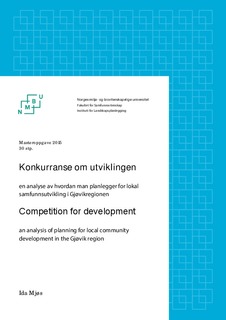| dc.description.abstract | Gjøvikregionen består av fem kommuner: Gjøvik, Vestre og Østre Toten, Nordre og Søndre Land. Fra langt tilbake i tid har disse vært selvstendige enheter som har hatt et levedyktig livsgrunnlag for sine innbyggere, gjennom de naturlige ressursene på stedet. Med tiden har dette endret seg. Kommunene har blitt avhengige av hverandre for å kunne fungere som levedyktige gjennom å skape en funksjonell region gjennom integrert bolig, arbeid og service. Det har oppstått en BAS-region. Gjennom denne funksjonelle regionen har det oppstått en administrativ region for å håndtere de overlappende funksjonene som går over til nabokommunene. Det blir vist til at Gjøvikregionen er en godt integrert region, indikert av høye pendlertall.
Østsiden av Mjøsa vil få en tilrettelagt utvikling i forbindelse med intercityforbindelsen og den kommende dobbeltsporede høyhastighetsbanen. Banen vil blant annet ha stopp ved Oslo, Gardermoen, Hamar og Lillehammer. Dette vil være med på å skape attraktivitet for både beboere og næringsetablering på østsiden. I tillegg vil avstanden fra Hamar til Gardermoen være like lang som avstanden fra Oslo til Gardermoen, en faktor som igjen skape ytterligere attraktivitet for både mennesker og næring. Dette skaper utfordringer for Gjøvikregionen på vestsiden av Mjøsa. De vil ikke dra fordel av dette på samme måte.
Spørsmål i denne oppgaven er hvordan man i Gjøvikregionen planlegger for lokal samfunnsutvikling for å håndtere blant annet konkurransen om utvikling og vekst i sammenheng med tilretteleggelsen som skjer på østsiden av Mjøsa.
Strategiene for å håndtere dette i regionen er gjennom å satse på fire faktorer: samferdsel, befolkningsvekst, næringsutvikling og kompetanse, mennesker med kompetanse. Den menneskelige ressursen står i sentrum. Disse strategiene kan komme av både statens argumentasjon for planlegging for lokal samfunnsutvikling, og av det regionale samarbeidet. Innen for samferdsel ligger fokuset på forbedring av Rv 4 og Gjøvikbanen, dette skal blant annet være med på å knytte regionen nærmere Oslo og hovedstadens arbeidsmarked. For å få dette til er man avhengig av det regionale samarbeidet i regionen. Dette er hovedelementet for å håndtere utfordringene som kommer av kommende veksten på østsiden av Mjøsa.
Abstract
The Gjøvik region is constituted by five municipalities: Gjøvik, Vestre Toten, Østre Toten, Nordre Land and Søndre Land. From earlier times these have been independent entities having viable livelihood for its citizens, based on their natural resources. Over time this has changed. The municipalities have become interdependent and a functional region has established. Through this functional region an administrative region has occurred dealing with the overlapping functions that go into the neighbouring municipalities. The Gjøvik region appears a well-integrated region, this is also substantiated by high commuter numbers.
The community on the east side of Mjøsa will get improved communication in connection with the upcoming intercity connection double track high-speed rail. The intercity connection will have stops at Oslo, Gardermoen, Hamar and Lillehammer. This will create attractiveness for both residents and enterprises. The distance from Hamar to Gardermoen will be the same distance as from Oslo to Gardermoen, which is a factor that will create additional attractiveness for both people and enterprises. This creates challenges for the Gjøvik region on the west side of Mjøsa, as they will not benefit to the same degree.
The main question of this master thesis is how the Gjøvik region is planning for local community development to deal with the competition for development and growth in the context to the improved communication system on the east side of Mjøsa.
The way the region deals with this is through four strategies: transportation, population growth, new enterprises and expertise, people with competence. These four strategies stems from the desire to create and develop an attractive community in the Gjøvik region, people being the main resource. These strategies may result from both the state's arguments for planning for local community development, and from regional cooperation. Within transportation, the focus is on the improvement of Rv 4 and Gjøvik rail, including the linking of the region closer to Oslo and the labour market there. Cooperation is the main element in handling the challenges that will come from improved communication and upcoming growth on the other side of Mjøsa. | nb_NO |
